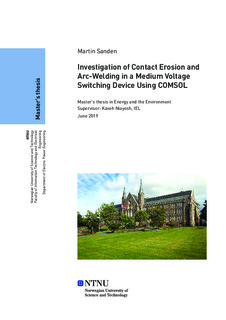| dc.contributor.advisor | Niayesh, Kaveh | |
| dc.contributor.author | Sanden, Martin | |
| dc.date.accessioned | 2019-10-16T14:00:34Z | |
| dc.date.available | 2019-10-16T14:00:34Z | |
| dc.date.issued | 2019 | |
| dc.identifier.uri | http://hdl.handle.net/11250/2622623 | |
| dc.description.abstract | Denne master oppgaven omhandler effektene lysbuen hadde på en mellomspennings effektbryter under lukkeoperasjoner. Hovedmålet for oppgaven var å finne den totale kontakterosjonen og styrken på lysbuesveisen etter at lukking hadde inntruffet.
Tre grunnmodeller ble laget i simuleringsprogrammet COMSOL. En for hver kontakt material undersøkt: kobber, wolfram og komposittmaterialet kobber-wolfram. Hver grunnmodell besto av en fast og en bevegelig elektrode. De endrede parameterne undersøkt, var kortslutningsstrømmen og aktiv lysbuetid.
Det ble funnet at ren kobber hadde den laveste styrken i forhold til kontakterosjon og lysbuesveising. I tillegg, viste resultatene at kobber-wolfram tolererte termiske belastinger best. Ved maksimum kortslutningsstrøm og lysbuetid ble det observert kontakterosjon på henholdsvis 26.88 mg, 17.37 mg og 15.45 mg for kobber, wolfram og kopper-wolfram.
Kontaktmaterialet kobber-wolfram ble videre undersøkt for å se på innvirkningen materialdistribusjon hadde på kontakterosjon og lysbuesveising. Resultatene viste at kontaktmaterialet med høyt innhold av wolfram, presterte best.
Kort oppsummert viser undersøkelsen av kontaktmaterialet kobber-wolfram at en økning av wolfram partikler i elektrodene, reduserte kontakterosjon og styrken på lysbuesveisen. Resultatene indikerte at kontaktmaterialet kobber-wolfram fungerer godt med tanke på termiske belastinger under lukkeoperasjoner. | |
| dc.description.abstract | This master’s thesis addressed the effect pre-strike arc had on a medium-voltage switching devices during making operation. The main aims were to find the amount of contact erosion and arc-weld strength after the making operation had occurred.
Three base models were developed in COMSOL. One for each contact material simulated: copper, tungsten and copper-tungsten. Each base model consisted of a fixed and a moving contact. The changing parameters were the short-circuit current and the arcing time.
It was found that pure copper had the lowest strength toward contact erosion and arcwelding. Additionally, the results showed that copper-tungsten tolerated these thermal stresses best. At maximum short-circuit current and arcing time, the contact erosion for the contact materials copper, tungsten and copper-tungsten were 26.88 mg, 17.37 mg and 15.45 mg, respectively.
The contact material copper-tungsten were further examined, to see the impacts material distribution had on contact erosion and arc welding. The results showed that the contact material with high tungsten density performed the best.
Altogether, when examining copper-tungsten, it was found that increasing the amount of tungsten particles present at the contacts, reduced both contact erosion and arc welding strength. These results indicates that the contact material copper-tungsten is good with regards to thermal stresses during making operations. | |
| dc.language | eng | |
| dc.publisher | NTNU | |
| dc.title | Investigation of Contact Erosion and Arc-Welding in a Medium Voltage Switching Device Using COMSOL | |
| dc.type | Master thesis | |
